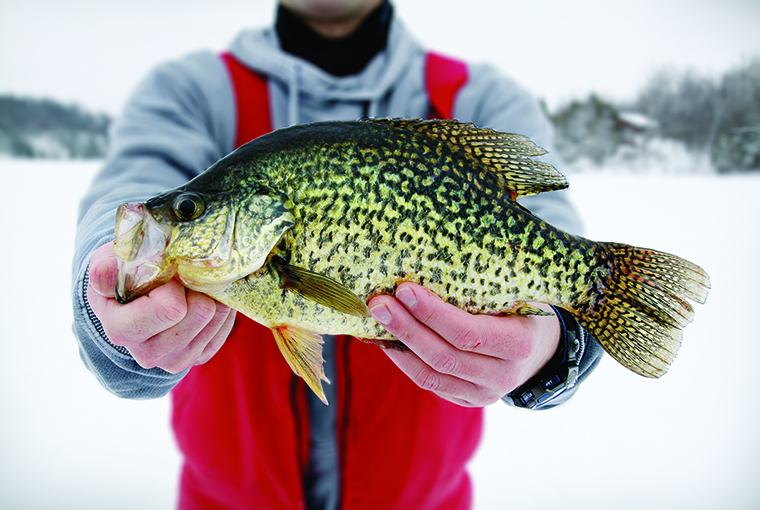
Tackle shop owners hear the same sad confessions year after year. Anglers were either sitting over schools of crappie that refused to bite, or fish which where stacked like cordwood one day and gone the next.
The game
The game of winter crappie fishing is as much about charming and finessing as it is about having the grit and muster to find fish in spite of winter’s harshness.
What tends to complicate the learning process is that most anglers thinly spread their limited fishing time across many species and different waterbodies. Even if we get lucky some days, the data on which we base our opinions is complicated and incomplete. All too often, we leave a tough day not really knowing if fish were just off the bite or we just found where the motherlode was residing.
A fun experiment I’ve conducted over the past few years with crappie is to devote a good percentage of my
fishing effort to a few relatively small pothole lakes in my area of eastern Ontario. These lakes are simple in structure, and I have made sure to visit each one repeatedly throughout the ice-fishing season. It’s a case study, of sorts, which has helped me validate some of the basic and not-so-basic beliefs about crappie. Many of these observations can be applied to other parts of the province.
Pre-ice pointers
For any serious ice angler, the fishing season starts before ice actually sets in. There’s no better way to understand a crappie’s habitat than to scope it out from a boat during open water. The pothole lakes in this case happen to be clear and quite shallow (maximum 15 feet), so calm days and bright sun are ideal for visually searching large areas for distinct weedlines, pockets, or other shallow structure. Map out these areas with a GPS and be sure to make notes as reminders of why you plotted them.
You might choose to develop a system whereby various icons represent different types of cover. On this particular set of lakes, my waypoints tend to reflect distinct edges along rocky points and weedlines bordering open water.
The greenest and most well-developed vegetation during autumn is broadleafed cabbage, although any healthy, green vegetation gets marked. This is also the time to revisit areas you might have found during the previous winter, in order to understand why they were productive. For example, one hot spot I stumbled across was an isolated clump of vegetation about the size of a house separated from the main weedline.
First-ice considerations
There’s general agreement first ice offers some of the best fishing of the year, in part due to the fact that fish have yet to see any real angling pressure. Last winter, ice formed early, allowing me to be on it by early December. The vegetation was so thick, however, that using low power on the narrowest transducer angle possible on my fish finder was essential to get a sonar signal through it. A good sonar unit is paramount to consistent crappie fishing. Marking fish that refuse to bite is an obvious cue to change your presentation.
Like most lakes, there are a few community holes that offer good fishing close to main access points. These spots historically hold crappie and provide a productive first-ice bite, which dwindles quickly as fishing pressure increases. Ice is relatively thin at season’s start, making cutting holes easy, so travelling light and covering water virtually guarantee success.
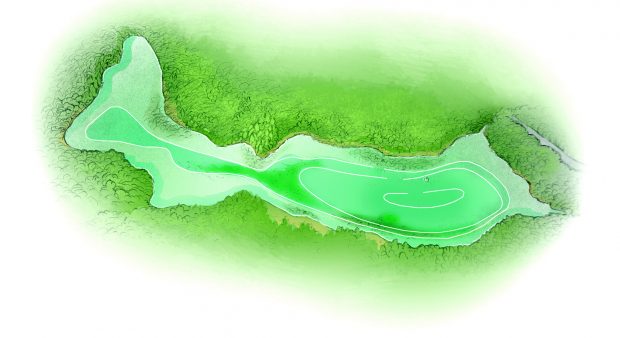
“Subtle baits, subtle strikes”
Crappie in these lakes are largely piscivorous. As much as I love a good fish fry, I tend to release most of the fish I catch, but almost always keep a few to analyze their stomach contents. Rock bass, perch, sunfish, and other crappie dominate the slabs’ diet.
It shouldn’t be all that surprising, then, how well larger, more aggressive presentations tend to work on naive fish. Upsized crappie baits that produce consistently include the 21⁄4-inch Williams Whitefish (J50) and the two-inch Salmo Chubby Darter (CD5). Modify the Whitefish by removing the double side hooks and sliding a small tube bait over the remaining treble.
Bigger lures defy what most anglers consider to be a refined presentation for crappie, but when fish are active, the larger lure profile can draw them in from greater distances, especially where heavy vegetation might reduce a fish’s line of sight. Large baits can also be particularly effective at tempting strikes from bigger crappie that might otherwise turn their snouts up at more diminutive offerings. There’s an old adage: “Subtle baits prompt subtle strikes.” Attacks on larger baits, though, can be startling.
Pike abound in the lakes referred to, so an 8-inch fluorocarbon leader prevents lures from being bitten off. I tie my own using 40-pound-test fluoro. Attach a small snap or tie directly to the lure using a loop knot to allow your lure freedom of movement.
Even when crappie won’t hit larger baits, curiosity often gets the best of them. If you can draw them into your area, you can usually pick them off with subtle presentations. Rather than reeling up, simply drop a small tube jig or other crappie offering alongside the larger lure, to reduce the chances of startling the fish or having them wander off.
Mid-winter notes
As winter progresses, well-known spots become less and less predictable. This is when a logical, well-organized search pattern is an absolute necessity. Drop an auger hole every 20 paces or so, zig-zagging along waypoints you mapped out during open water. Make the holes closer once you contact fish. Weedlines generally correspond with the 7-foot contour on these waterbodies, and while the outer edge is a key spot, fish often will be well inside the vegetation. This greatly expands the number of places crappie might be hiding, but the good thing is they rarely travel alone. If you find one, more are certain to be nearby.
In order to travel light and prevent thick ice from slowing you down, use a 4.5-inch hand auger. With this outfit, if you’re in good shape, you can cut holes all day. Replace the blades at the start of each season, though, to ensure they’re as sharp as possible. A 13-inch crappie is tough to get through a 4.5-inch hole, though, so tuck an ice chipper into your sled, as well, to expand holes.
Experimenting key
Crappie express varying levels of aggressiveness throughout the day, as well as from one day to the next, so experiment with an array of lures to test their preferences. Horizontal glide baits like Jigging Rapalas and Nils Masters, as well as various sizes and colours of spoons and jigs, all have their time and place.
One presentation that should get considerably more use later in the season is the dropper rig. A pair of maggots on a No. 14 thin wire hook hung 6 inches below a small attractor spoon is about as subtle as a crappie presentation can get. Bites can be virtually undetectable, though, requiring an occasional lift to check if a fish is on.
Moving on
Even when you find fish, how long should you stay there? If crappie are moving, sitting tight could pay dividends. Prime movements usually take place at first and last light. If fish are not moving, you could spend a long, cold day looking at a blank sonar screen. Move frequently. Even when fish are present on your screen, if they don’t want to bite, leave and come back later. Your time is better spent looking for active biters.
Winter can be a stressful time for crappie. Their metabolisms are already running extremely slowly, and low oxygen content in the water is a real problem on many shallow lakes. Fish clinging to survival are not always the most willing biters.
This is why inflowing creeks are a magnet for fish during late ice. The infusion of oxygen, and perhaps even
nutrients, keeps vegetation green.
Yet, one of the most challenging periods last season occurred during a major mid-winter melt. Water flowing out of a creek discoloured a large portion of one lake and the bite took weeks to recover. Be aware of such drastic changes and never rule out a lake or a particularly good-looking spot just because of one bad trip.
Last-ice observations
Last ice corresponds with the final melting trend that ultimately leads to open water. Reduced snow pack and melting water reinvigorate the stagnant underworld. Crappie activity cranks up a notch, and bigger baits again make first string. Even the community holes seem to again have active fish.
On another note, last year the ice got exceptionally thick by the end of the season, so power augers were key
to remaining mobile. Keep this in mind for this winter.
One observation this case study demonstrated clearly to me is that, even with the most sophisticated ice fishing equipment, under the most controlled circumstances, there will be days when you can expect to work long and hard just to cover the base of a frying pan with crappie fillets. I think this is the way it should be, though. Otherwise, we might not appreciate the good days quite as much.
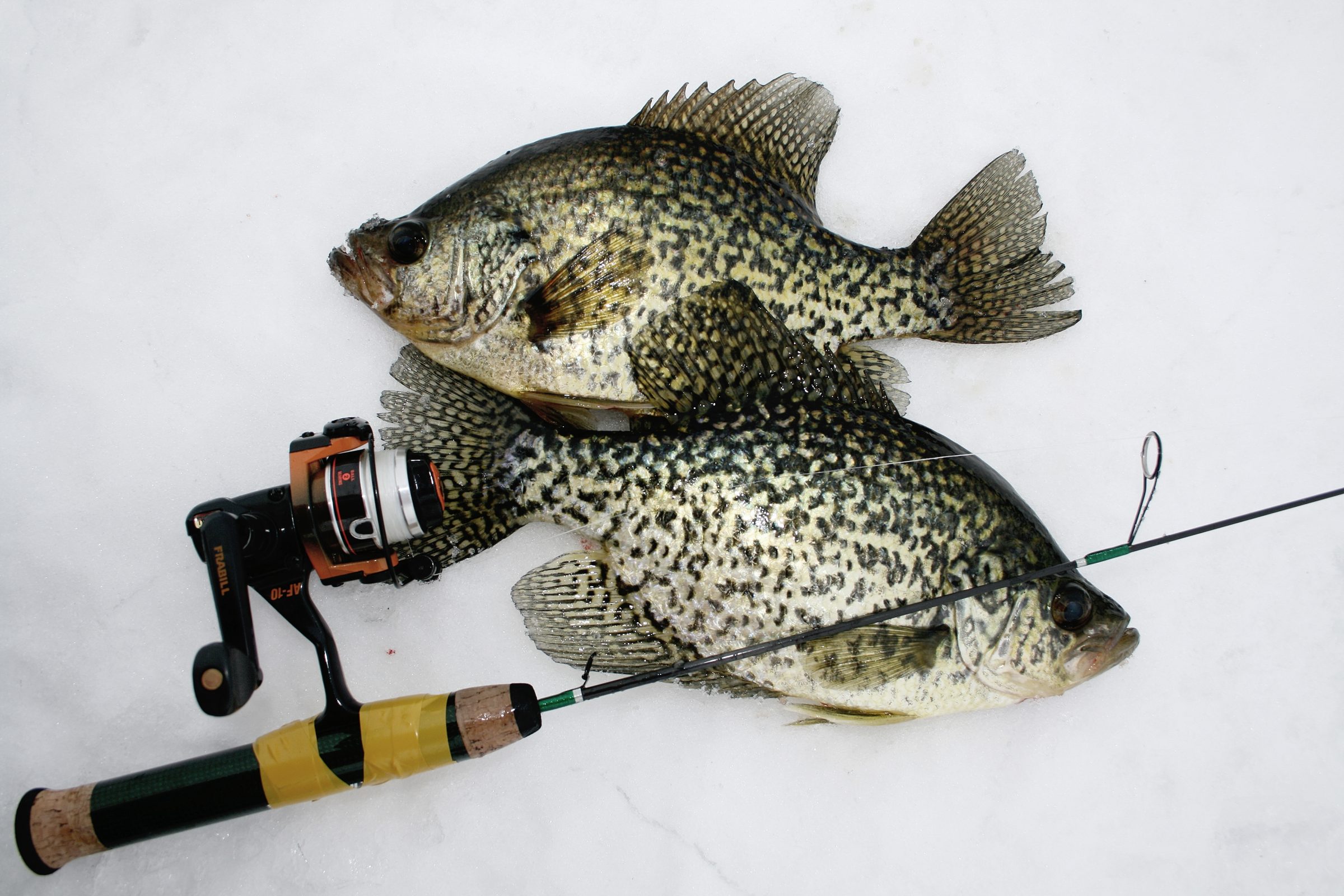
Key elements of success
A few tips which should serve you well in figuring out your local lake:
- Scout during open water – use GPS to mark likely looking spots – be sure to make notes.
- When searching on the ice, travel light. Use a small sharp auger, but keep a chipper packed in the sled.
- Carry a wide variety of baits and be sure to experiment.
- Don’t overlook big baits. They can be deadly at drawing fish in and triggering strikes from slabs.
- Seek out inflowing streams at late ice, but be sure to approach with caution especially during melt periods.
- Revisit community holes at last ice, and be don’t overlook upsizing your baits.
Weedline crappies
During summer, much of the lake is choked with vegetation. Lily pads and bulrushes rim the lake margins. Much of this vegetation will die off in autumn and many of the larger predatory fish get squeezed out of the shallows once ice forms. Deeper vegetation, particularly weed lines, are prime crappie hangouts. Only delve into the expansive flats after you have thoroughly inspected high percentage spots such as:
- Community access point – local community hole – easily recognizable spot – prominent main lake point with thick weed growth adjacent to good rock structure. Hit it early and then be prepared to move on as fishing pressure sets in.
- Inflowing stream – Can provide oxygen and nutrients to keep vegetation green. Particularly good late ice location.
- Potential sweet spots like isolated patches of aquatic vegetation, set apart from main weed line.
- Less obvious rocky points which squeeze the adjacent weed line into a narrower band. Rocky substrates open up pockets in the vegetation.
- The deepest hole in the lake is not a draw for fish in this scenario, but on other lakes the entire population may concentrate here.
- Not all vegetation is created equal. Variations in bottom substrate and water currents may cause weedlines to die out and become sparse.
Originally published in the Winter 2008-2009 issue of Ontario OUT of DOORS magazine.


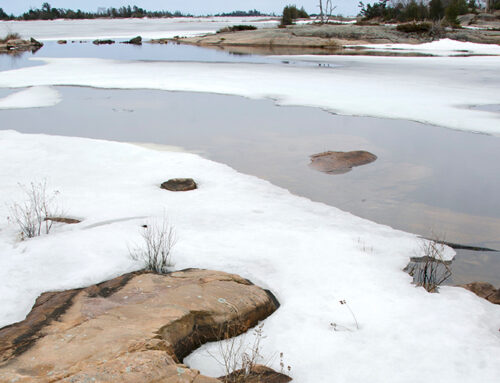
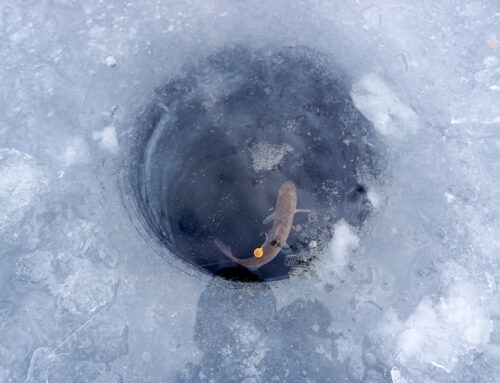
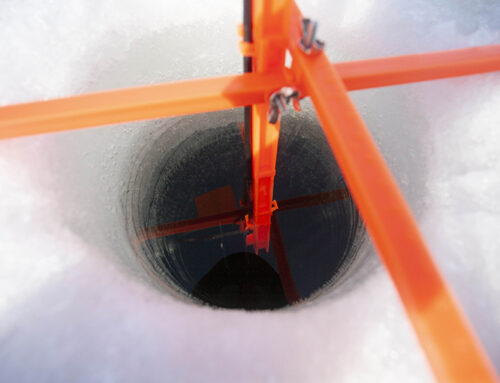
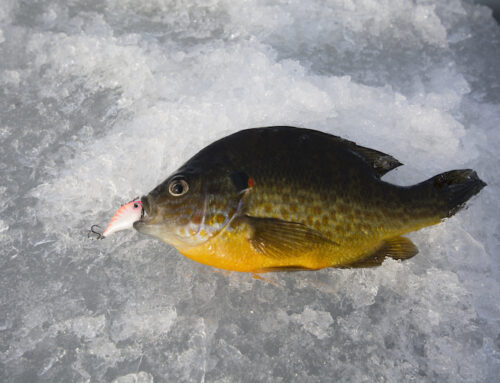
Leave A Comment